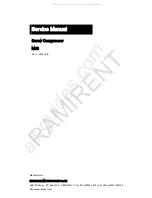
FORM 220.11-NM2 (602)
21
YORK INTERNATIONAL
The Lubrication System
See Figure 7 for models with a Series lubrication sys-
tem. See Figure 8 for models with a Parallel lubrication
system.
The location of the auxiliary oil pump, within the sys-
tem, determines whether the lubrication system is in
Series or Parallel. If the auxiliary oil pump suction is
through the centrifugal shaft driven pump discharge,
the lubrication system is in Series. If the auxiliary oil
pump suction is directly from the oil reservoir, the lu-
brication system is in Parallel.
The lubricating system consists of the shaft driven main
oil pump (1), auxiliary oil pump (2), oil filter (3), oil
cooler (4), the oil reservoir (5) and all interconnecting
oil piping. There are four main points of lubrication,
within the YORK Turbomaster Compressor, which
must be supplied with forced feed lubrication by the
main oil pump (1) and the auxiliary oil pump (2) as
follows:
1. Thrust Bearings (6) (Active/Reverse)
2. Main Bearing – Suction End (7)
3. Main Bearing – Discharge End (8)
4. Atmospheric Shaft Seal (9)
The main oil pump (1) is a centrifugal type of YORK
design. It is bolted to and is directly driven by a hex on
the end of the rotor shaft. The auxiliary oil pump (2) is
an electric type pump and is used to establish oil pres-
sure before operating the compressor. It is typically
mounted on the side of the compressor or on the base
near the compressor.
The Oil Circuit
To trace the oil flow through the compressor see Figure
7 for models with a Series lubrication system and Fig-
ure 8 for models with a Parallel lubrication system. The
main oil pump (1) takes suction from the oil reservoir
(5) and discharges through the oil filter(s) (3).
From the oil filter(s) (3), the oil flow is divided as
follows:
1. Part of the oil flows to the discharge end main bear-
ing (8) and thrust bearing (6).
2. The remainder of the oil flows to the suction end
main bearing (7) to lubricate the main bearing and
shaft seal.
At the discharge end, oil from the oil filter(s) (3) enters
a drilled passage in the side of the oil reservoir hous-
ing (5) and flows to the space around the shaft between
the thrust bearing (6) and the discharge end main bear-
ing (8). From this space, part of the oil passes through
the main bearing (8) toward the impellers and the re-
mainder passes to the load surface of the thrust bearing
(inboard surface of oil pump and outboard surface of
thrust bearing).
Oil passes through the discharge end main bearing (8)
toward the impellers into the space between the oil res-
ervoir (5) and seal ring housing. This oil drains into
the oil reservoir (5). The discharge end oil seal (10) is
so designed that some gas from the balance piston leaks
into the oil reservoir (5). Typically the oil reservoir pres-
sure is equalized with a low stage impeller inlet pres-
sure as outlined under External Sump Vent Equalizing
Line.
The oil which lubricates the thrust surface (inboard
surface of oil pump and outboard surface of thrust bear-
ing) flows through the cooler (4) and returns to the
main pump (1) via the oil jet pump nozzle (11). As
this oil flows through the jet pump (11), additional oil
from the reservoir (5) is induced to flow to the main
oil pump (1).
The oil which flows from the filter (3) to the suction
end of the compressor enters the bearing housing and
flows through a drilled passage to an annular space
around the suction end main bearing (7). The main bear-
ing (7) is drilled radially to permit the oil to flow into
the bearing surfaces. Part of this oil flows through the
main bearing (7) (toward the impellers and suction end
oil seal (12)) and drains back to the reservoir (5) through
the external oil return line.
The remainder of the oil in the suction end main bear-
ing (7) flows into, and completely floods, the shaft seal
space. From the shaft seal (9) the oil passes to the shaft
seal cavity oil reservoir, with a small amount passing
to lubricate “O-rings” in the PRV cover plate. Any oil
leaking through to the atmospheric side of the shaft
seal (9) drains by gravity to the oil recovery system, if
equipped, or the atmospheric seal oil drain tank (13)
which is cast into the underside leg of the compressor
housing.
To facilitate checking oil temperatures in the lubrica-
tion system, thermometers (14, 15, and 16) are typi-
cally located as follows:
3
Summary of Contents for Turbomaster M Series
Page 15: ...FORM 220 11 NM2 602 15 YORK INTERNATIONAL FIG 3 TYPICAL PRIMARY COMPRESSOR GAS FLOW LD07318 3 ...
Page 16: ...YORK INTERNATIONAL 16 FORM 220 11 NM2 602 FIG 4A MAJOR COMPONENTS LD07319 Operation ...
Page 31: ...FORM 220 11 NM2 602 31 YORK INTERNATIONAL Operation 3 This page intentionally left blank ...
















































